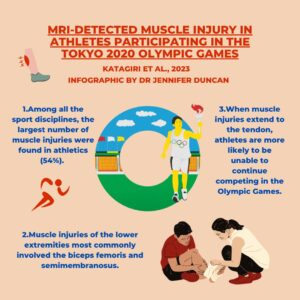Keywords: Tendon, athletes, Tokyo
This blog will explain the results of an epidemiological surveillance that investigated muscle injuries incurred during the Tokyo 2020 Olympic Games. This study helped athletes and their medical teams make decisions on whether or not to continue competing.
Our study (recently published in BJSM) was conducted during the Tokyo 2020 Olympic Games, where we collaborated with the Tokyo Medical and Dental University, Dokkyo Medical University Saitama Medical Center, University of British Columbia, Oslo University Hospital, Oslo Sports Trauma Research Center, and University of Pittsburgh (1).
Why is this study important?
Muscle injuries can derail training and preparation. When they occur during competitions, they can prevent athletes from showcasing the best of their abilities. When a muscle injury is experienced by an elite athlete during training or competition, they and their medical team are faced with the ultimate athlete’s dilemma—deciding whether to continue competing and judging whether they risk further harm by doing so. This is not an easy choice given that the chance to compete in the Olympic Games often comes only once in a lifetime. Conducting epidemiological surveillance of sports injuries, including muscle strain incidence, is a fundamental first step in the sequence of evidence-based injury management, treatment, and prevention strategies. This epidemiological surveillance is highly significant as it was conducted at the Olympic Games, which is the world’s largest sporting event, with up to 10,000 participating athletes from more than 200 countries engaging in multiple sports. This provides the most heterogeneous study cohort of elite athletes and the best opportunity to contribute to the field. Our findings will contribute information that can help athletes and their medical teams make informed decisions.
How did the study go about this?
Our research group reviewed magnetic resonance images (MRIs) of muscle injuries experienced by athletes during the Tokyo Olympic Games. We reported the demographic data of athletes who suffered muscle injuries, characteristics of muscle injuries, incidence of muscle injuries for each sport, and anatomical location of muscle injuries by sport. Anatomical site classifications for each muscle injury was determined using the British Athletics Muscle Injury Classification (BAMIC).
What did the study find?
Our study identified 59 MRI-detected muscle injuries in 40 male and 19 female athletes. Among all the sport disciplines, the largest number of muscle injuries were found in athletics (32/59, 54%). Muscle injuries of the lower extremities most commonly involved the biceps femoris and semimembranosus. Twenty-one injuries (35%) were myofascial injuries in the peripheral aspect of the muscle, 14 injuries (24%) involved muscle tendon junctions, and 24 injuries (41%) extended into the tendon. Furthermore, 24 athletes (41%) were unable to fully compete in their event.
Competition results were stratified by muscle injury site classification. The proportion of athletes who were unable to finish competing was significantly higher for athletes with muscle tears that extended to the tendon than for athletes with tears in the muscle belly or peripheral part of the injured muscle.
What are the key take-home points?
This wide data pool provided high-quality findings that helped us understand which types of muscle tears were more likely to prevent athletes from competing. When muscle injuries extend to the tendon, athletes are more likely to be unable to continue competing in the Olympic Games.
This is just the first step of our dream to assist athletes and their medical teams when faced with dilemmas related to sports injuries, and we will continue to engage in further studies with current and future collaborators.

References:
- Katagiri H, Forster BB, Engebretsen L, et alEpidemiology of MRI-detected muscle injury in athletes participating in the Tokyo 2020 Olympic Games British Journal of Sports Medicine 2023;57:218-224.
Authors and affiliations:
Hiroki Katagiri